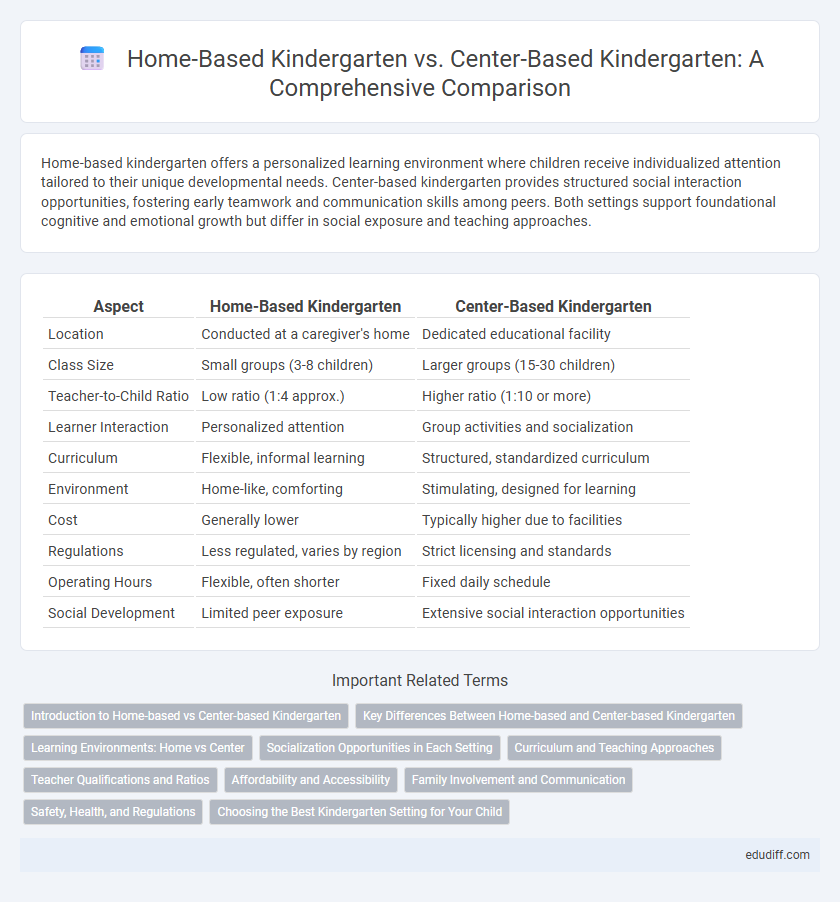Home-based kindergarten offers a personalized learning environment where children receive individualized attention tailored to their unique developmental needs. Center-based kindergarten provides structured social interaction opportunities, fostering early teamwork and communication skills among peers. Both settings support foundational cognitive and emotional growth but differ in social exposure and teaching approaches.
Table of Comparison
| Aspect | Home-Based Kindergarten | Center-Based Kindergarten |
|---|---|---|
| Location | Conducted at a caregiver's home | Dedicated educational facility |
| Class Size | Small groups (3-8 children) | Larger groups (15-30 children) |
| Teacher-to-Child Ratio | Low ratio (1:4 approx.) | Higher ratio (1:10 or more) |
| Learner Interaction | Personalized attention | Group activities and socialization |
| Curriculum | Flexible, informal learning | Structured, standardized curriculum |
| Environment | Home-like, comforting | Stimulating, designed for learning |
| Cost | Generally lower | Typically higher due to facilities |
| Regulations | Less regulated, varies by region | Strict licensing and standards |
| Operating Hours | Flexible, often shorter | Fixed daily schedule |
| Social Development | Limited peer exposure | Extensive social interaction opportunities |
Introduction to Home-based vs Center-based Kindergarten
Home-based kindergarten programs offer personalized learning environments with flexible schedules, fostering close interaction between children and caregivers. Center-based kindergartens provide structured curricula, diverse socialization opportunities, and specialized staff to support early childhood development. Parents often choose between these options based on factors like convenience, social exposure, and educational goals for their children.
Key Differences Between Home-based and Center-based Kindergarten
Home-based kindergartens offer personalized, flexible learning environments with fewer students, fostering close parent-teacher interactions and a homelike atmosphere. Center-based kindergartens provide structured curricula, socialization opportunities, certified teachers, and access to specialized resources and facilities. Key differences include the scale of operation, regulatory standards, educational approach, and social engagement levels.
Learning Environments: Home vs Center
Home-based kindergartens provide a personalized learning environment with familiar surroundings that can enhance comfort and individual attention, fostering early social and cognitive development. Center-based kindergartens offer structured settings equipped with diverse learning materials and social interaction opportunities that promote group activities and peer collaboration. Research indicates that the learning environment significantly influences children's adaptability, engagement, and early academic skills development in both settings.
Socialization Opportunities in Each Setting
Home-based kindergarten offers personalized socialization in a familiar environment, promoting close-knit interactions with family and a small group of peers, which supports emotional security but may limit diverse social experiences. Center-based kindergarten provides structured socialization with a larger, more diverse group of children, fostering essential skills like cooperation, communication, and conflict resolution in varied peer interactions. Both settings contribute differently to social development, with home-based environments focusing on intimate social bonds and center-based programs emphasizing broader social engagement.
Curriculum and Teaching Approaches
Home-based kindergartens offer personalized, flexible curricula tailored to individual child needs, often integrating family values and daily routines into learning. Center-based kindergartens provide structured, standardized curricula aligned with early childhood education standards, utilizing collaborative, group-based teaching approaches that promote social development. Both models emphasize experiential learning, but center-based settings typically incorporate more diverse resources and specialized teaching staff.
Teacher Qualifications and Ratios
Home-based kindergartens typically feature lower student-to-teacher ratios, allowing for more personalized attention, but teacher qualifications may vary widely and are often less standardized compared to center-based programs. Center-based kindergartens usually require educators to hold formal certifications or degrees in early childhood education, ensuring consistent teaching quality and adherence to state or national standards. Maintaining optimal teacher-to-child ratios in both settings is crucial for fostering effective learning and development during early childhood.
Affordability and Accessibility
Home-based kindergarten offers greater affordability due to lower overhead costs and flexible scheduling, making early education accessible to families with limited budgets. Center-based kindergartens often provide structured programs and diverse resources but may require higher fees and fixed hours, potentially limiting access for some communities. Families prioritize affordability and accessibility by weighing cost savings of home-based care against the comprehensive offerings of center-based options.
Family Involvement and Communication
Home-based kindergartens foster closer family involvement through personalized daily interactions, allowing parents to actively participate in their child's learning environment. Center-based kindergartens utilize structured communication channels such as parent-teacher conferences and digital apps to maintain consistent updates on child development. Both settings emphasize collaboration but differ in the scale and frequency of family engagement, impacting the depth of parental connection and support.
Safety, Health, and Regulations
Home-based kindergartens often offer personalized care but may face challenges meeting rigorous safety, health, and regulatory standards compared to center-based kindergartens. Center-based kindergartens typically adhere to stringent state licensing requirements, ensuring certified staff, regular health inspections, and structured safety protocols. Regulatory compliance in center-based settings promotes enhanced child safety measures, allergen control, and emergency preparedness, which are critical for early childhood development environments.
Choosing the Best Kindergarten Setting for Your Child
Choosing the best kindergarten setting for your child depends on factors such as your child's social development needs, learning style, and family schedule. Home-based kindergartens offer personalized attention and a familiar environment, which can be ideal for children requiring close guidance and flexibility. Center-based kindergartens provide structured group activities and social interaction, fostering early teamwork and diverse learning experiences crucial for childhood development.
Home-based kindergarten vs Center-based kindergarten Infographic

 edudiff.com
edudiff.com